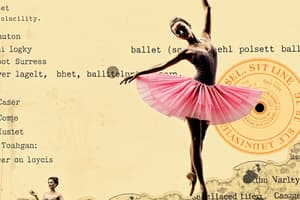Podcast
Questions and Answers
What is the primary distinction between a demi plié and a grand plié?
What is the primary distinction between a demi plié and a grand plié?
- Demi plié keeps the knees straight while grand plié bends them fully.
- Demi plié is done with feet in fifth position while grand plié is not.
- Demi plié is performed without any foot placement, while grand plié requires a specific foot position.
- Demi plié involves bending the knees halfway with heels on the ground, while grand plié involves fully bending the knees. (correct)
What does the term 'relevé' refer to in ballet?
What does the term 'relevé' refer to in ballet?
- The act of bending the knees while keeping the heels grounded.
- A slow movement characterized by control and strength.
- Balancing on tippy toes with feet pointed toward the ground. (correct)
- A position that describes movements performed facing backward.
Which of the following correctly describes a battement tendu?
Which of the following correctly describes a battement tendu?
- A movement where the leg is extended from a closed position to an open position while the foot is on the floor. (correct)
- Extending the leg from a closed to an open position with the foot off the floor.
- A movement where the foot is pointed and circles in the air.
- Rising onto the tips of the feet without bending the knees.
What does the term 'en croix' refer to in ballet movements?
What does the term 'en croix' refer to in ballet movements?
Which ballet term describes the action of bending the supporting leg while extending the other leg?
Which ballet term describes the action of bending the supporting leg while extending the other leg?
What does 'sous-sus' involve?
What does 'sous-sus' involve?
What is the effect of performing movements 'à terre'?
What is the effect of performing movements 'à terre'?
Which of the following describes the term 'coupé' in ballet?
Which of the following describes the term 'coupé' in ballet?
Flashcards are hidden until you start studying
Study Notes
Basic Ballet Positions and Movements
- Demi Plié: Knees bend halfway; heels remain on the ground.
- Grand Plié: Knees bend fully; thighs parallel to the floor.
- Relevé: Rising onto the balls of the feet; strengthens feet and legs.
- Elevé: Rising onto the balls of the feet without bending knees.
- En Croix: Movements performed in a cross pattern: front, side, back, side.
- Passé: One leg bent, foot near the knee of the other leg, forming a triangle.
- Devant: Position or movement to the front.
- Derrière: Position or movement to the back.
- Battement Tendu: Leg extends from closed to open position, foot on the floor.
- Battement Dégagé: Leg slightly lifts off the floor, then returns to a closed position.
Ballet Terminology
- Adagio: Slow movements requiring strength, balance, and control (e.g., pliés).
- Rond de jambe: Circular movement of the foot, in the air or on the ground; foot pointed.
- à terre: On the ground; movements performed with the working leg on the ground (e.g., rond de jambe à terre).
- Soutenu: Sustained turn from fifth position, rising onto the toes, arms raised in an oval. Builds balance and control.
- Sous-sus: Rising onto the balls of the feet in fifth position, feet in contact. A transitional movement.
- En l’air: In the air; describes movements performed in the air.
- Fondue: "To melt"; bending the supporting leg while the other leg is extended.
- En dedans: Inward circular movement of the leg toward the supporting leg.
- En dehors: Outward circular movement of the leg away from the supporting leg.
- Coupé: "To cut"; one foot replaces the other; often a transitional movement or position. The foot not on the ground is placed on the ankle of the standing leg.
Studying That Suits You
Use AI to generate personalized quizzes and flashcards to suit your learning preferences.





